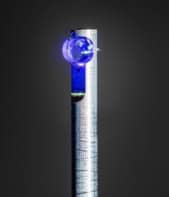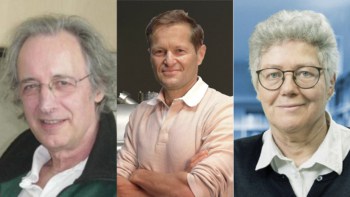
Physicists in the US have come up with a way of making photons repel each other by sending them through an ultracold atomic gas. This astonishing feat could lead to the creation of “photon crystals” and exotic quantum states such as a Mott insulator.
Photons have zero rest mass and zero charge, and as they zip past each other at the speed of light, they barely feel each other’s effects. Physicists, however, have devised various means to amplify this tiny photon-photon interaction.
In 2013, a team led by Vladan Vuletić at the Massachusetts Institute of Technology and Mikhail Lukin of Harvard University created an attractive interaction by firing photons into an ultracold atomic gas, putting some atoms into an energetic “Rydberg state”. While travelling through the gas, the photons tended to stick together more often than they would have had the gas not been there.
Slow-moving quasiparticles
“Classically speaking, the photon comes in, gets absorbed by one atom and propels it to a Rydberg state,” explains Vuletić. “After a while, the photon gets released and absorbed by another atom, which stays in the Rydberg state a while and so on. Quantum mechanically, the gas is in a superposition state of all these possibilities.” These photon-atom couplings can be described as slow-moving quasiparticles called polaritons that interact with each other much more strongly than photons.
Using this technique to create repulsive interactions, however, is trickier. Polaritons interact by changing the local refractive index of the medium. To switch this interaction from attractive to repulsive, requires polaritons that shift the local refractive index in the opposite direction. While this can be achieved by changing how the incident light is detuned, this shift also gives the polaritons negative effective mass. “For one sign of detuning, the particles attract each other” explains Vuletić: “The other side of the detuning, you change both the interaction and the mass term – and the particles still attract each other.”
In 2014 Lukin’s group teamed-up with theoretical physicist Hans-Peter Buchler of the University of Stuttgart in Germany to develop a mathematical description of slow-light polaritons. Under certain specific conditions, the team proposed, repulsive interactions between the polaritons should dominate. Unfortunately, when Lukin and Vuletić’s groups tried to realize these conditions, they found it impossible: “We don’t think this proposal was wrong,” says Vuletić, “It just wasn’t practical in our system and required very, very high laser power that we were not able to reach.”
Two atomic states
After exploring several possibilities, the two groups have now devised and demonstrated a successful alternative scheme in which the photons are coupled simultaneously to two atomic states in the same atom. “Coupling the photons to matter not just once but twice gives us another free parameter where we were able to alter the mass of the particles independently from the index of refraction,” explains Vuletić. Using this, the researchers showed that, by tuning the wavelength of the incident light, they could alter whether or not photons exiting the gas were more or less likely to do so together than would have been expected by chance. This showed that they could control whether polaritons in the gas attracted or repelled each other. The researchers went on to demonstrate three-body repulsion between polaritons, which matched their theoretical predictions.

Physicists create ‘molecules’ of light
The researchers are now exploring several possible extensions of the work: “If you have repulsion at short distances and attraction at long distances you would create a molecular-like structure,” explains Lukin’s student Aditya Venkatramani, who along with Vuletić’s student Sergio Cantu were joint first authors of a paper in Nature Physics that describes the work.
This could create “crystalline order” in photon structures, potentially opening up experiments impossible in traditional matter. “If you have an atom interacting, it always has the same mass no matter how it travels around,” explains Cantu, “but here you could have a mass of one sign and magnitude in one direction and another sign and magnitude in another direction. It’s possible to change a lot of parameters that, in regular matter, are just given by your material.”
“It’s really cool,” says Mohammed Hafezi of the University of Maryland, College Park. He suspects the work will unlock many doors in photon many-body physics that were hitherto closed by the fact that all attractions between polaritons were attractive. He is excited, for example, by the potential of producing an exotic quantum state called a Mott insulator with photons: “You need repulsive interactions to have a traffic jam of photons,” he explains, “They’ve now achieved a repulsive bond, and if they manage to have a finite number of modes and to populate them, then they should get a Mott insulator.”



